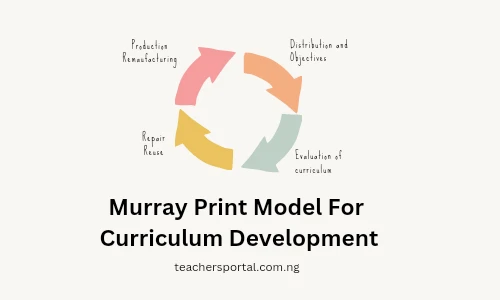In this article, we will explore the Murray Print Model for Curriculum Development.
The Murray Print Model for Curriculum Development prescribes a sequential and logical approach to curriculum development, offering a useful and easy-to-understand process. Widely employed, this model serves as a framework for developing and evaluating curriculum. Its sequential, logical, and systematic nature provides educators with a clear roadmap to follow.
Features of Murray Print Model
- Prescriptive and Rational: The model provides a clear and specific set of steps, ensuring a straightforward and understandable implementation process for educators.
- Cyclical and Dynamic: Despite its linear presentation, the model recognizes the necessity of revisiting and revising the curriculum. This adaptability is crucial, allowing adjustments based on feedback and evolving data.
- Focuses on Aims, Goals, and Objectives: The model begins by identifying overarching educational goals and then meticulously breaks them down into specific, achievable objectives. This focus ensures a comprehensive and targeted approach to curriculum development.
- Includes Instructional Evaluation: Emphasizing the significance of ongoing assessment, the model incorporates instructional evaluation. This feature underscores the need to regularly evaluate the effectiveness of the curriculum, enabling educators to make informed adjustments for continual improvement.
Phases of Murray Print Model
Phase 1: Organization
The initial phase of Print’s model is dedicated to recognizing the nature of the curriculum. In this phase, curriculum workers engage in the following key activities:
- Identifying Individuals: Curriculum workers meticulously identify and involve the key individuals who play a role in the development of the curriculum.
- Assumptions Exploration: This phase involves a critical examination of the underlying assumptions about learning and teaching that will serve as guiding principles for the curriculum.
- Exploration of Underlying Forces: Curriculum workers delve into the exploration of the underlying forces or foundations that influence thinking about education. This comprehensive examination helps establish a solid foundation for the curriculum, ensuring that it is grounded in the broader context of educational philosophy and principles.
Phase 2: Development
Moving into the second phase, the Development phase of the Murray Print Model involves a systematic approach to crafting the curriculum. Key components of this phase include:
- Situational Analysis: A thorough examination of the contextual factors surrounding curriculum implementation is conducted. This includes a comprehensive analysis of the needs of the learners, available resources, and environmental constraints.
- Aims and Goals Definition: Clearly defining the overall aims and goals of the curriculum is a pivotal step. This establishes a framework that aligns with the broader educational objectives, ensuring coherence and purpose in the curriculum.
- Content and Objectives Development: Specific content and objectives are meticulously developed based on the situational analysis.
- Learning Activities Design: With the content and objectives in place, the next step involves designing engaging and effective learning activities. These activities are tailored to facilitate student understanding and achievement of the defined objectives, promoting a dynamic and enriching learning experience.
- Instructional Evaluation Planning: Recognizing the importance of ongoing assessment, the Development phase includes the formulation of a plan for instructional evaluation.
Phase 3: Application
The final phase, Application, focuses on bringing the developed curriculum into practical use. This phase unfolds in a series of key steps:
- Implementation: The curriculum is put into practice during this stage. Educators, in collaboration with relevant stakeholders, execute the curriculum plan in a real-world learning environment.
- Monitoring and Feedback: Rigorous monitoring of curriculum implementation takes place to gauge its real-time impact. Continuous feedback is provided to both teachers and students, fostering a dynamic feedback loop.
- Curriculum Evaluation: The effectiveness of the curriculum is systematically evaluated during this critical stage. Comprehensive assessments are conducted to measure the curriculum’s impact on student learning outcomes and overall educational goals. Based on the evaluation findings, adjustments are made as needed, promoting an adaptive approach to curriculum development and refinement. This cyclical process ensures that the curriculum remains responsive to changing educational dynamics.
The evaluation results provide insight into the curriculum’s applicability and goal attainment. The integrated monitoring and feedback system aids in timely revisions, and the model is versatile, suitable for curriculum development at various levels—local, college-wide, or national.
Strengths and weaknesses of the Murray Print Model
Strengths
- Provides a clear and logical framework for curriculum development.
- Easy to understand and implement.
- Emphasizes the importance of aims, goals, and objectives.
- Includes instructional evaluation.
Weaknesses
- Can be seen as too prescriptive and inflexible.
- Does not take into account the individual needs of learners.
- Can be time-consuming and resource-intensive to implement.
